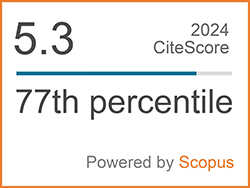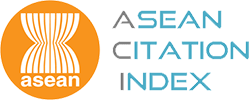Molecular Docking and in vivo Toxicity Evaluations of Jopan Nanoherbal (Clibadium surinamense L.) Leaves in a Zebrafish Model
Abstract
Keywords
[1] S. Kaushal, N. Priyadarshi, P. Garg, N. K. Singhal, and D. K. Lim, “Nano-biotechnology for bacteria identification and potent anti-bacterial properties: A review of current state of the art,” Nanomaterials, vol. 13, no. 2529, pp. 1–25, 2023.
[2] E. K. Sher, M. Alebić, M. M. Boras, E. Boškailo, E. K. Farhat, A. Karahmet, B. Pavlović, F. Sher, and L. Lekić, “Nanotechnology in medicine revolutionizing drug delivery for cancer and viral infection treatments,” International Journal of Pharmaceutics, vol. 660, 2024, Art. no. 124345.
[3] X. Han, K. Xua, O. Taratulab, and K. Farsadc, “Applications of nanoparticles in biomedical imaging,” Nanoscale, vol. 11, no. 3, pp. 799–819, 2019.
[4] C. G. P. Rumahorbo, S. Ilyas, S. Hutahaean, and C. F. Zuhra, “Bischofia javanica and Phaleria macrocarpa nano herbal combination on blood and liverkidney biochemistry in oral dquamous cell carcinoma-induced rats,” Pharmacia, vol. 71, pp. 1–8, 2024.
[5] P. C. Situmorang, S. Ilyas, S. Hutahaean, and R. Rosidah, “Components and acute toxicity of nanoherbal haramonting (Rhodomyrtus tomentosa),” Journal of HerbMed Pharmacology, vol. 10, no. 1, pp. 139–148, 2021.
[6] A. Hussain, F. Attique, S. A. R. Naqvi, A. Ali, M. Ibrahim, H. Hussain, F. Zafar, R. S. Iqbal, M. A. Ayub, M. A. Assiri, M. Imran, and S. Ullah, “Nanoformulation of curcuma longa root extract and evaluation of its dissolution potential,” ACS Omega, vol. 8, no. 1, pp. 1088–1096, 2023.
[7] T. Teame, Z. Zhang, C. Ran, H. Zhang, Y. Yang, Q. Ding, M. Xie, C. Gao, Y. Ye, M. Duan, and Z. Zhou, “The use of zebrafish (Danio rerio) as biomedical models,” Animal Frontiers, vol. 9, no. 3, pp. 68–77, 2019.
[8] S. S. Balan, P. Manokaram, S. Maya, H. Bahari, M. M. Uzid, M. Danial, A. Z. Abidin, A. D. Jesus, and M. Rahmadi, “Evaluation an aqueous extract of irradiated and non irradiated of Orthosiphon aristatus on zebrafish embryo (Danio rerio) through acute toxicity assay,” Trends in Sciences, vol. 19, no. 14, p. 4980, 2022.
[9] S. K. Verma, A. Nandi, A. Sinha, P. Patel, S. Mohanty, E. Jha, S. Jena, P. Kumari, A. Ghosh, I. Jerman, R. S. Chouhan, A. Dutt, S. K. Samal, Y. K. Mishra, R. S. Varma, P. K. Panda, N. K. Kaushik, D. Singh, and M. Suar, “The posterity of zebrafish in paradigm of in vivo molecular toxicological profiling,” Biomedicine and Pharmacotherapy, vol. 171, 2024, Art. no. 116160.
[10] J. Xavier and K. Kripasana, “Acute toxicity of leaf extracts of Enydra fluctuans Lour in zebrafish (Danio rerio Hamilton),” Scientifica, vol. 2020, pp. 1–6, 2020.
[11] M. D’amora, V. Raffa, F. D. Angelis, and F. Tantussi, “Toxicological profile of plasmonic nanoparticles in zebrafish model,” International Journal of Molecular Sciences, vol. 22, no. 12, pp. 1–32, 2021.
[12] N. Tavvabi-Kashani, M. Hasanpour, V. B. Rahimi, N. Vahdati-Mashhadian, and V. R. Askari, “Pharmacodynamic, pharmacokinetic, toxicity, and recent advances in Eugenol’s potential benefits against natural and chemical noxious agents: A mechanistic review,” Toxicon, vol. 238, 2024, Art. no. 107607.
[13] J. J. Li, Y. X. Yue, S. J. Shi, and J. Z. Xue, “Investigation on toxicity mechanism of halogenated aromatic disinfection by-products to zebrafish based on molecular docking and QSAR model,” Chemosphere, vol. 341, 2023, Art. no. 139916.
[14] W. Sents, E. Ivanova, C. Lambrecht, D. Haesen, and V. Janssens, “The biogenesis of active protein phosphatase 2A holoenzymes: A tightly regulated process creating phosphatase specificity,” FEBS Journal, vol. 280, no. 2, pp. 644–661, 2013.
[15] F. P. Guengerich, “A history of the roles of cytochrome P450 enzymes in the toxicity of drugs,” Toxicological Research, vol. 37, no. 1, pp. 1–23, 2021.
[16] K. Fujii, K. Yamakawa, Y. Takeda, N. Okuda, A. Takasu, and F. Ono, “Understanding the pathophysiology of acute critical illness: Translational lessons from zebrafish models,” Intensive Care Medicine Experimental, vol. 12, no. 8, pp. 1–8, 2024.
[17] D. P. Wati, S. Ilyas, and D. Khairani, “In silico study of compounds from nanoherbal Jopan (Clibadium surinamense L.) leaves as inhibitors AKT1 interaction,” Trends in Sciences, vol. 22, no. 1, p. 8729, 2024.
[18] H. A. Alomar, W. M. El Kady, A. A. Mandour, A. A. Naim, N. I. Ghali, T. A. Ibrahim, and N. Fathallah, “Computational antidiabetic assessment of Salvia splendens L. polyphenols: SMOTE, ADME, ProTox, docking, and molecular dynamic studies,” Results in Chemistry, vol. 14, 2025, Art. no. 102081.
[19] W. Nafisah, F. Fatchiyah, M. H. Widyananda, Y. I. Christina, M. Rifa’I, N. Widodo, and M. S. Djati, “Potential of bioactive compound of Cyperus rotundus L. rhizome extract as inhibitor of PD-L1/PD-1 interaction: An in silico study,” Agriculture and Natural Resources, vol. 56, no. 4, pp. 751–760, 2022.
[20] P. S. Pallan, L. D. Nagy, L. Lei, E. Gonzalez, V. M. Kramlinger, C. M. Azumaya, Z. Wawrzak, M. R. Waterman, F. P. Guengerich, and M. Egli, “Structural and kinetic basis of steroid 17α,20-lyase activity in Teleost fish cytochrome P450 17A1 and its absence in cytochrome P450 17A2,” Journal of Biological Chemistry, vol. 290, no. 6, pp. 3248–3268, 2015.
[21] H. Rasyid and R. Armunanto, “Molecular docking analysis on epidermal growth factor receptor wild type (EGFR wt) with quinazoline derivative compounds as tyrosine kinase inhibitors,” Applied Science and Engineering Progress, vol. 10, no. 4, pp. 293–299, 2017, doi: 10.14416/j.ijast.2017.12.001.
[22] Y. H. Prayogo, A. W. Anggini, A. Carolina, E. G. T. Manurung, R. K. Sari, A. Purwoko, and G. Pasaribu, “In vitro and In silico antibacterial potency of eucalyptus leaf oil from hybrid clones of E. grandis with E. urophylla and E. pellita,” Applied Sciences and Engineering Progress, vol. 18, no. 3, 2025, Art. no. 7671, doi: 10.14416/j.asep.2025.01.002.
[23] OECD, OECD TG 453: Testing of Chemicals Combined Chronic Toxicity/Carcinogenicity Studies, 2018.
[24] A. Augustine and J. Xavier, “Toxicological evaluation of ethanolic leaf and fruit extracts of Phaseolus vulgaris L. treated with wastewater in Danio rerio hamilton (zebrafish),” Asian Journal of Plant Sciences, vol. 21, no. 1, pp. 24–31, 2022.
[25] S. Alam, G. Afzal, R. Hussain, H. M. Ali, A. Sami, R. M. Malik, R. Jabeen, F. S. Ataya, and K. Li, “Estimation of median LC50 and toxicity of environmentally relevant concentrations of thiram in Labeo rohita,” npj Clean Water, vol. 8, no. 1, p. 9, 2025.
[26] M. G. Shinde, S. J. Modi, and V. M. Kulkarni, “Synthesis, pharmacological evaluation, molecular docking and in silico ADMET prediction of nitric oxide releasing biphenyls as anti-inflammatory agents,” Journal of Applied Pharmaceutical Science, vol. 7, no. 10, pp. 37–47, 2017.
[27] K. Jurowski and A. Krośniak, “Prediction of key toxicity endpoints of AP-238 a new psychoactive substance for clinical toxicology and forensic purposes using in silico methods,” Scientific Reports, vol. 14, no. 1, 2024, Art. no. 28977.
[28] J. Bercu et al., “A cross-industry collaboration to assess if acute oral toxicity (Q)SAR models are fit-for-purpose for GHS classification and labelling,” Regulatory Toxicology and Pharmacology, vol. 120, 2021, Art. no. 104843.
[29] A. Balkrishna, S. Pokhrel, H. Singh, M. Joshi, V. P. Mulay, S. Haldar, and A. Varshney, “Withanone from withania somnifera attenuates sars-cov-2 rbd and host ace2 interactions to rescue spike protein induced pathologies in humanized zebrafish model,” Drug Design, Development and Therapy, vol. 15, pp. 1111–1133, 2021.
[30] S. Y. Khan, M. A. Rather, A. Shah, I. Ahmad, I. Ahmad, K. K. Saba, and F. R. Sofi, “Exploring 3D structure of gonadotropin hormone receptor using homology modeling, molecular dynamic simulation and docking studies in rainbow trout, Oncorhynchus mykiss,” Endocrine and Metabolic Science, vol. 15, 2024, Art. no. 100171.
[31] J. Zheng, T. Lin, and W. Chen, “Removal of the precursors of N-nitrosodiethylamine (NDEA), an emerging disinfection byproduct, in drinking water treatment process and its toxicity to adult zebrafish (Danio rerio),” Chemosphere, vol. 191, pp. 1028–1037, 2018.
[32] C. E. Enyoh, Q. Wang, P. E. Ovuoraye, and T. O. Maduka, “Toxicity evaluation of microplastics to aquatic organisms through molecular simulations and fractional factorial designs,” Chemosphere, vol. 308, 2022, Art. no. 136342.
[33] C. Vicidomini, R. Palumbo, M. Moccia, and G. N. Roviello, “Oxidative processes and xenobiotic metabolism in plants: Mechanisms of defense and potential therapeutic implications,” Journal of Xenobiotics, vol. 14, no. 4, pp. 1541–1569, 2024.
[34] P. Gupta, A. Mahapatra, A. Suman, and R. K. Singh, “In silico and in vivo assessment of developmental toxicity, oxidative stress response & Na+/K+-ATPase activity in zebrafish embryos exposed to cypermethrin,” Ecotoxicology and Environmental Safety, vol. 251, 2023, Art. no. 114547.
[35] Y. L. dos Santos Melo, A. C. Luchiari, B. S. Lopes, M. G. F. R. Silva, T. dos Santos Pais, J. E. P. G. Cortez, C. da Silva Camillo, S. A. Bezerra de Moura, J. K. da Silva-Maia, and A. H. de Araújo Morais, “Acute toxicity of trypsin inhibitor from tamarind seeds in embryo and adult zebrafish (Danio rerio),” Toxicology Reports, vol. 13, 2024, Art. no. 101766.
[36] R. de Carvalho Rocha Koga, G. Custodio de Souza, A. V. Tavares de Lima Teixeira, A. M. Ferreira, B. L. Sánchez-Ortiz, L. Silva Abreu, J. F. Tavares, and J. C. T. Carvalho, “Hydroethanolic extracts from Bauhinia guianensis: A study on acute toxicity in zebrafish embryos and adults,” Pharmaceutical Biology, vol. 62, no. 1, pp. 577–591, 2024.
[37] R. Fakhlaei, J. Selamat, A. F. Abdull Razis, R. Sukor, S. Ahmad, A. Khatib, and X. Zou, “Development of a zebrafish model for toxicity evaluation of adulterated Apis mellifera honey,” Chemosphere, vol. 356, Art. no. 141736, 2024.
[38] D. L. Zhang, C. X. Hu, D. H. Li, and Y. D. Liu, “Lipid peroxidation and antioxidant responses in zebrafish brain induced by Aphanizomenon flos-aquae DC-1 aphantoxins,” Aquatic Toxicology, vol. 144–145, pp. 250–256, 2013.
[39] N. Jiang, P. Song, X. Li, L. Zhu, J. Wang, X. Yin, and J. Wang, “Dibutyl phthalate induced oxidative stress and genotoxicity on adult zebrafish (Danio rerio) brain,” Journal of Hazardous Materials, vol. 424, 2022, Art. no. 127749.
[40] E. Paduraru, R. Jijie, I. A. Simionov, C. M. Gavrilescu, T. Ilie, D. Iacob, A. Lupitu, C. Moisa, C. Muresan, L. Copolovici, D. M. Copolovici, G. Mihalache, F. D. Lipsa, G. Solcan, G. A. Danelet, M. Nicoara, A. Ciobica, and C. Solcan, “Honey enriched with additives alleviates behavioral, oxidative stress, and brain alterations induced by heavy metals and imidacloprid in zebrafish,” International Journal of Molecular Sciences, vol. 25, no. 21, 2024, Art. no. 11730.
[41] M. Fricker, A. M. Tolkovsky, V. Borutaite, M. Coleman, and G. C. Brown, “Neuronal cell death,” Physiological Reviews, vol. 98, no. 2, pp. 813–880, 2018.
[42] L. Gence, D. Fernezelian, M. Bringart, B. Veeren, A. Christophe, F. Brion, O. Meilhac, J. L. Bascands, and N. Diotel, “Hypericum lanceolatum Lam. medicinal plant: Potential toxicity and therapeutic effects based on a zebrafish model,” Frontiers in Pharmacology, vol. 13, 2022, Art. no. 832928.
[43] J. C. T. Carvalho, G. C. De Souza, I. D. R. Da Silva, M. D. Viana, N. C. De Melo, B. L. Sánchez-Ortiz, M. M. R. De Oliveira, W. R. Barbosa, and I. M. Ferreira, “Acute toxicity of the hydroethanolic extract of the flowers of Acmella oleracea l. in zebrafish (Danio rerio): Behavioral and histopathological studies,” Pharmaceuticals, vol. 12, no. 4, p. 173, 2019.
[44] D. S. Omnes, J. Xavier, and A. Suresh, “Assessing oral acute toxicity and histopathological effects of Strelitzia reginae Aiton leaf extracts in Zebrafish (Danio rerio Hamilton),” Plant Science Today, vol. 11, no. 2, pp. 262–270, 2024.
[45] L. Ma, Z. Yin, Q. Xie, Y. Xu, Y. Chen, Y. Huang, Z. Li, X. Zhu, Y. Zhao, W. Wen, H. Xu, and X. Wu, “Metabolomics and mass spectrometry imaging reveal the chronic toxicity of indoxacarb to adult zebrafish (Danio rerio) livers,” Journal of Hazardous Materials, vol. 453, p. 131304, 2023.
[46] F. Yu, Y. Liu, W. Wang, S. Yang, Y. Gao, W. Shi, H. Hou, J. Chen, and R. Guo, “Toxicity of TPhP on the gills and intestines of zebrafish from the perspectives of histopathology, oxidative stress and immune response,” Science of the Total Environment, vol. 908, 2024, Art. no. 168212.
[47] F. H. Holanda, A. N. Ribeiro, B. L. Sánchez-Ortiz, G. C. de Souza, S. F. Borges, A. M. Ferreira, A. C. Florentino, S. A. Yoshioka, L. S. Moraes, J. C. T. Carvalho, and I. M. Ferreira, “Anti-inflammatory potential of baicalein combined with silk fibroin protein in a zebrafish model (Danio rerio),” Biotechnology Letters, vol. 45, no. 2, pp. 235–253, 2023.
[48] A. A. de Souza, B. L. S. Ortíz, S. F. Borges, A. V. P. Pinto, R. da S. Ramos, I. C. Pena, R. D. C. R. Kago, C. E. Batista, G. C. de Souza, A. M. Ferreira, S. D. Junior, and J. C. T. Carvalho, “Acute toxicity and anti-inflammatory activity of Trattinnickia rhoifolia Willd (Sucuruba) using the zebrafish model,” Molecules, vol. 27, no. 22, p. 7741, 2022.
[49] J. Zhang, Q. Chen, Y. Wang, R. Wang, R. Wang, X. Hao, Y. Zheng, X. An, and J. Qi, “Protective effects of feruloyl oligosaccharides from fermented wheat bran againsoxidative stress in IPEC-J2 cells in vitro and in a zebrafish model in vivo,” Journal of Food Quality, vol. 2022, no. 1, 2022, Art. no. 8001728.
DOI: 10.14416/j.asep.2025.07.007
Refbacks
- There are currently no refbacks.
 Applied Science and Engineering Progress
Applied Science and Engineering Progress







